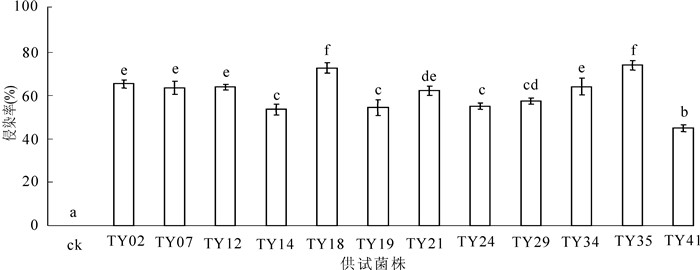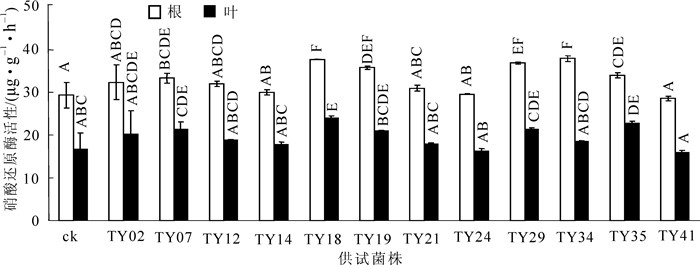-
氮元素是植物生长所需要的重要的大量元素元素之一,在植物生长过程中起到关键作用。菌根真菌氮元素的吸收利用研究被人们所关注[1-2]。通过接种,菌根真菌能有效地促进植株对氮素的吸收利用[3-5]。特殊内生菌根杜鹃花类菌根(ericoid mycorrhiza,ERM),对杜鹃花类植物克服恶劣环境、加强养分吸收和提高生长量起着重要作用[6-8]。ERM菌根共生体能够帮助杜鹃花科Ericaceae植物缓解环境压力,改善营养获取方式,吸收复杂有机态的氮[9-10]。张春英等[11]报道了云锦杜鹃Rhododendron fortunei幼苗接种形成菌根苗后,能提高对各种氮源营养的吸收,直接表现为增加植株的干物质积累。桃叶杜鹃Rhododendron annae为常绿灌木,成年树冠为圆球形,花色丰富,花期为晚春,主要分布于贵州海拔1 800~1 830 m高山地区,在城市园林建设中具有较高的开发应用潜力。野生桃叶杜鹃菌根结构复杂且侵染率较高[12],通过接种,菌根真菌提高了菌根苗叶片的叶绿素含量,增强光合性能,促进了碳同化的高效运转和有机物的积累,提高了菌根苗同源激素含量,最终表现为菌根苗生物量的增加[13-14]。笔者研究ERM菌株接种后对桃叶杜鹃菌根苗硝酸还原酶(NR)活性和氮元素积累的影响,为桃叶杜鹃等高山常绿杜鹃菌根化园林栽培应用提供理论依据与技术支持。
-
12株供试菌株从野生桃叶杜鹃根部分离得到,编号为TY02,TY07,TY12,TY14,TY18,TY19,TY21,TY24,TY29,TY34,TY35和TY41[14]。分离菌株培养液为PDA培养基,置于28 ℃摇床上黑暗振荡160 r·min-1,培养15 d打碎并制成液体菌剂备用。
-
试验苗为实验室通过种子和土壤灭菌后培养的2年生实生桃叶杜鹃苗。育苗基质采自百里杜鹃风景区桃叶杜鹃林下腐殖质土,土样带回实验室进行土壤理化性质试验。供试土壤理化性质如下:pH 4.8,有机质44.1 g·kg-1,全氮1.5 g·kg-1,全磷0.2 g·kg-1,碱解氮269.0 mg·kg-1,速效磷7 mg·kg-1,速效钾206. mg·kg-1。
-
育苗基质经121 ℃高温蒸汽灭菌2 h,自然冷却后80 ℃烘2 h,然后放置室温后装入花盆(规格24 cm × 16 cm × 20 cm)。花盆装基质3 kg·盆-1,移植无菌桃叶杜鹃幼苗1株·盆-1。接种处理采用单因素完全随机设计,试验设13个处理(含对照ck),5盆·处理-1,重复3次。移栽3 d后每株苗根部各施入真菌液体菌剂10 mL,以浇不含菌的PDA培养液为对照,以后隔7 d浇1次菌液,连续浇3次结束,试验处理严格保证土壤微生物区系一致。接种后随机放置贵州大学林学院苗圃温室进行培养,按照常规育苗方法进行管理。
-
接种培养180 d后,随机取出幼苗10株·盆-1,流水洗净后吸干水分,在105 ℃杀青20 min,置于80 ℃烘箱48 h烘干至恒量,取出后分别称量地下部分(根)和地上部分(叶、茎和芽)的干质量,计算总生物量。采用Phillips等[15]的改进法统计侵染率。测定苗分地下根系及地上部分全氮采用H2SO4-H2O2消煮-半微量蒸馏法。用分光光度计测定法测定硝酸还原酶(NR)活性。以上测试重复3次。
-
运用Excel 2003记录及绘图;使用SPSS 11.5软件进行统计分析,采用单因素方差分析(one-way ANOVA),应用Duncan多重分析法进行方差检验(P=0.01)。
-
从图 1可以看出:接种苗菌根侵染率达到45.0%~74.1%。不同菌株对幼苗的侵染率表现出差异性,说明不同菌株与幼苗之间有相互选择性。
-
从表 1可以看出:不同菌株侵染对桃叶杜鹃地上部分和地下根系生物量的影响存在显著差异,接种苗地上部分干质量比对照增加2.5%~99.7%,地下部分干质量增加6.0%~27.3%,接种苗总生物量比对照增加3.9%~61.2%。从植株外观上也明显看出接种对宿主生物量的影响较大(图 2)。
表 1 不同ERM菌株接种对桃叶杜鹃幼苗干质量的影响(平均值±标准差)
Table 1. Effects of inoculation with different ericoid mycorrhizal strains on growth of Rhododendron annae seedling (mean±SD)
处理 地上部分生物量 地下部分生物量 总生物量 干质量/g 增幅/% 干质量/g 增幅/% 干质量/g 增幅/% ck 0.213±0.003 A 0.0 0.183±0.027 A 0.0 0.396±0.030 A 0.0 TY02 0.335±0.001 D 57.3 0.210±0.011 ABCDE 14.4 0.544±0.010 E 37.4 TY07 0.267±0.004 C 25.3 0.212±0.008 DCDE 15.8 0.479±0.004 D 21.0 TY12 0.365±0.001 E 71.4 0.223±0.004 CDE 21.6 0.588±0.004 E 48.5 TY14 0.219±0.007 AB 2.7 0.203±0.006 ABCD 10.7 0.411±0.010 AB 3.8 TY18 0.425±0.009 G 99.7 0.214±0.012 BCDE 16.5 0.639±0.021 F 61.4 TY19 0.275±0.006 C 29.3 0.197±0.002 ABC 7.6 0.473±0.005CD 19.4 TY21 0.260±0.002C 21.9 0.206±0.006 ABCDE 12.5 0.466±0.004 CD 17.7 TY24 0.235±0.005 B 10.3 0.201±0.010 ABCD 9.8 0.436±0.008 BC 10.1 TY29 0.397±0.001 F 86.4 0.233±0.015 CD 27.3 0.630±0.014 F 59.1 TY34 0.259±0.030 C 21.6 0.204±0.006 ABCD 11.3 0.463±0.033 CD 16.9 TY35 0.377±0.002 EF 76.8 0.227±0.006 DE 23.8 0.604±0.008 EF 52.5 TY41 0.218±0.002 AB 2.5 0.194±0.002 AB 6.0 0.413±0.004 AB 4.3 说明:同列不同大写字母表示差异达到极显著水平(P < 0.01)。 -
由图 3可见:接种苗地上部分叶的氮质量分数均高于对照,除TY19,其他菌根差异极显著(P < 0.01),较未接种处理,接种幼苗叶部氮质量分数提高2.8%~50.6%。地下根系氮质量分数除TY19低于对照外(差异不显著),其他处理均高于对照,且差异极显著(P < 0.01),接种苗根部氮质量分数提高2.0%~40.3%。这表明通过接种处理后,增强了幼苗对氮的吸收,但不同菌株之间的影响有差异。

图 3 不同ERM菌株接种对桃叶杜鹃幼苗氮的影响
Figure 3. Effect on nitrogen content in Rhododendron annae seedling inoculationed with different strains of ericoid mycorrhizae
从图 4可以看出:不同菌株接种提高了幼苗硝酸还原酶活性,且各处理差异极显著(P < 0.01)。接种苗根部硝酸还原酶活性除TY41外,高于对照0.9%~29.3%,叶部硝酸还原酶活性除TY41和TY24外,高于对照6.5%~43.9%。不同器官硝酸还原酶活性表现为根系 > 叶片。
-
从表 2相关性分析可知:侵染率与地下部分干质量呈极显著正相关,与总生物量和叶部硝酸还原酶活性呈显著相关关系。这表明侵染率的高低直接影响桃叶杜鹃幼苗的生物量积累、硝酸还原酶活性。根部及叶部硝酸还原酶活性与地上干质量、总生物量有相关性,但叶部的相关性大于根部;叶部硝酸还原酶活性与叶部氮质量分数呈极显著正相关关系。
表 2 菌根侵染率、生物量、氮吸收量及硝酸还原酶活性Pearson相关系数
Table 2. Pearson correlation coefficient of mycorrhizal colonize, biomass, nitrogen content and nitrate reductase activity
项目 侵染率 地下部分干质量 地下部分干质量 总生物量 根部氮量分数 叶部氮质量分数 根部硝酸还原酶活性 叶部硝酸还原酶活性 侵染率 1 地下部分干质量 0.706** 1 地上部分干质量 0.584 0.831** 1 总生物量 0.613* 0.872** 0.996** 1 根部氮质量分数 0.595 0.308 0.119 0.144 1 叶部氮质量分数 0.565 0.451 0.490 0.496 0.360 1 根部硝酸还原酶活性 0.515 0.505 0.647* 0.642* 0.207 0.423 1 叶部硝酸还原酶活性 0.579* 0.653 0.815** 0.806** 0.194 0.272** 0.763** 1 说明:*差异达到显著水平(P < 0.05);**差异达到极显著水平(P < 0.01)。 -
研究桃叶杜鹃菌根氮效应极有意义,因为对于杜鹃花科植物来说,土壤中能供给此类植物的氮养分多数以有机态形式存在,因此在杜鹃花科植物氮养分吸收中菌根共生体起到了重要的作用。对于杜鹃花类菌根吸收利用氮素的原因可能有:①由于杜鹃花生长土壤为酸性土,pH值较低,土壤中铵盐比硝酸盐多,氮素矿物化过程缓慢,氨离子在土壤中的流动性不大,其扩散速度一般会小于根的吸收速度,所以,杜鹃花类植物的吸收根周围会形成一个缺氮区。根外菌丝越过缺氮区能够把远处的铵盐吸收到菌根中来。②ERM真菌的吸收系统对氮有很高的亲和力,能在含氮量少的低浓度溶液中吸收氨离子。③利用植物所不能利用的或很少利用的有机氮源[16]。
本研究得出桃叶杜鹃幼苗接种后,地上部分与地下部分的氮含量均显著增加,说明菌根真菌促进了幼苗对氮的吸收与利用。这与云锦杜鹃菌根苗试验结果相似[11, 17]。宋福强等[18]认为菌根改善宿主植物的氮营养状况的作用主要表现在2个方面,一是根外菌丝直接吸收土壤氮的作用;二是菌根首先改善植物的磷营养状况,进而促进植物对土壤氮的吸收作用。菌根真菌提高植物对氮、磷元素的吸收报道很多,桃叶杜鹃接种后根部与叶部的磷含量均比对照增加且大于氮的吸收强度(文章待发),有些宿主吸收氮的强度大于磷,这可能与不同宿主及不同菌根有关,因此,菌根是否先通过改善植物的磷营养状况,进而促进植物对土壤氮的吸收有待试验和验证。施氮情况下,菌根宿主云锦杜鹃[11]、刺槐Robinia pseudoacacia[19]生物量增加,吸氮量及硝酸还原酶活性发生变化。由于本研究所有基质均一致,未额外添加不同氮源,所以菌根真菌吸收和利用氮源情况及与宿主的共生机理关系还需进一步深入研究。
Foissner等[20]采用激光共聚焦的方法发现真菌激发子诱导烟草表皮细胞浆和叶绿素的一氧化氮迸发。一氧化氮影响植物的生长发育等生理代谢过程,而硝酸过原酶硝酸还原酶普遍具有合成一氧化氮的功能。Kaiser等[21]发现,硝酸还原酶催化NO2-产生的一氧化氮在脱落酸诱导气孔关闭的过程中有重要的作用,通过对脱落酸钝感型等突变体的研究发现,由硝酸还原酶催化生成的一氧化氮是脱落酸诱导气孔关闭所必需。在相关性分析数据中,桃叶杜鹃菌根苗根部硝酸还原酶与地下根部生物量相关,与地上部和总生物量显著相关,叶部硝酸还原酶与地上根部生物量相关,与地上部和总生物量极显著相关。接种后菌根苗体内的脱落酸含量增加[15],这说明生物量的增加与接种真菌具有很大关系。硝酸还原酶是一种诱导酶,同时是一种调节酶和限速酶,存在于植物的根部质体中和叶绿体中,菌根真菌是如何激活和诱导硝酸还原酶,菌根植物硝酸还原酶是如何合成一氧化氮等分子机制有待深入研究。
Nitrate reductase activity and N absorption of Rhododendron annae seedlings with ericoid mycorrhiza inoculation
-
摘要: 研究12株杜鹃花类菌根(ericoid mycorrhiza, ERM)菌株对2年生桃叶杜鹃Rhododendron annae幼苗生长及矿质元素氮积累的影响。结果表明:接种ERM真菌的植株根系均被有效地感染, 不同菌株促生效应显著, 接种ERM真菌显著增加幼苗地上、地下部分及总生物量。与对照相比, ERM菌株接种后, 显著提高了接种幼苗氮质量分数和硝酸还原酶(NR)活性, 且各处理差异极显著(P < 0.01)。接种苗根部氮质量分数提高了2.0%~40.3%, 叶部提高了2.8%~50.6%。接种苗根部硝酸还原酶活性除菌株TY41外, 其余处理高于对照0.9%~29.3%, 叶部除菌株TY41和菌株TY24外, 高于对照6.5%~43.9%。不同器官硝酸还原酶活性表现为根系大于叶片。Abstract: To measure growth and N accumulation in two-year-old Rhododendron annae seedlings, twelve ericoid mycorrhiza (ERM) fungal strain isolates were used for inoculation. The test design set 13 treatments (including ck), each disposed 5 trees, 3 times repeated. The inoculated method was soil inoculation. Results showed that ERM fungi colonized the seedling roots improving biomass of seedling aboveground and belowground parts. Compared to uninoculated controls, inoculation with different ERM strains showed a highly significant increase (P < 0.01) for N content in the leaves and roots of seedlings as well as nitrate reductase (NR) activity. Root N content increased 2.0%-40.3%, and foliar N increased 2.8%-50.6%. Except for TY14, root NR activity was higher than the control (0.9%-29.3%), and except for TY41 and TY24, foliar NR activity was higher than the control 6.5%-43.9%. NR activity in different organs showed root>leaf. ERM fungal strain promoted the growth, NR activity and N content of R. annae seedlings, which meant to promote seedling nitrogen absorption and utilization. Effects of mycorrhiza varied by different ERM fungi strain.
-
Key words:
- botany /
- ericoid mycorrhiza(ERM) /
- nitrogen /
- nitrate reductase /
- Rhododendron annae
-
森林与湿地、海洋并称为全球三大生态系统,被誉为“地球之肺”“绿色水库”和“物种基因库”[1]。森林生态系统是陆地生态系统中面积最大、组成结构最复杂、生物种类最丰富、适应性最强、稳定性最大、功能最完善、与人类生存发展关系最密切的一种自然生态系统,对改善和维护生态环境起着决定性的作用[2-3]。森林不仅能够为人类提供清新的空气、清洁的水源和舒适宜人的气候环境等生态产品,还能够提供保持水土、涵养水源、防风固沙、调节气候、生物多样性保育等生态服务[4]。CONSTANZA等[5]对全球生态系统服务价值进行较为全面的评估,算出全球陆地生态系统服务功能平均每年的价值高达33万亿美元,相当于当年全世界国民生产总值的1.8倍,不仅在国际上引起了广泛关注,而且掀起了对生态系统服务价值研究的热潮。联合国千年生态系统评估组(millennium ecosystem assessment,MA)开展了全球尺度和33个地区的生态系统与人类福利的研究,对生态系统的内涵、分类、评价基本理论和方法均进行了深入的阐述,极大推进了生态系统服务在世界范围内的理论方法及应用方面的研究[6]。侯元兆等[7]在国外生态服务价值评估的基础上,第1次估算出中国森林资源的价值约13.7万亿元,开创了国内森林生态系统生态服务价值评估的先河。有学者分别从不同尺度对中国、浙江省、泰顺县的森林生态系统服务价值进行评估[8-10]。也有学者分别对草原、湿地、森林等不同类型的生态系统进行价值评估[11-14]。本研究依据LY/T 1721−2008《森林生态系统服务功能评估规范》[15],对乌岩岭国家级自然保护区森林生态系统服务的物质量及价值量进行评估,有助于增进人们对森林环境的保护意识以及对自然保护区的重视程度。
1. 研究区概况
乌岩岭国家级自然保护区(27°20′52″~27°48′39″N,119°37′08″~119°50′00″E)地处浙江省泰顺县西北部,总面积约18 861.5 hm2,其中林业用地17 605.1 hm2,占土地总面积的93.3%。乌岩岭在全球陆生生物圈的地带生物群落分类中属于热带、暖温带交错区,由于地理位置处于28°N附近的敏感区,且靠近太平洋,加上保护区西北面高山阻隔,温度偏高。乌岩岭有775属种子植物,其中,包括中国种子植物属的15个分布区类型。乌岩岭国家级自然保护区是中国—日本森林植物亚区华东区与华南区过渡地带,无论是地形、地势、气候等非生物因素和动植物种群都呈现明显过渡性。乌岩岭国家级自然保护区被誉为物种基因库,森林覆盖率为92.8%,其中阔叶林蓄积量达28 万m3以上,所占比例为45%,是华东地区保存最完善的大面积原生性中亚热带常绿阔叶林[16]。
2. 研究方法
2.1 数据来源
数据来源有乌岩岭国家级自然保护区典型森林样地调查数据(2017年)、乌岩岭国家级自然保护区森林资源二类清查数据(2017年)、泰顺县气象局监测数据和中华人民共和国林业行业标准LY/T 1721−2008《森林生态系统服务功能评估规范》。不同类型林分净生产力和土壤年固碳量采用华东地区森林生态系统定位站的观测数据[17]。
2.2 评估内容与指标体系
依据LY/T 1721−2008《森林生态系统服务功能评估规范》,同时结合乌岩岭国家级自然保护区森林生态系统的实际情况,本次评估选取固碳释氧、涵养水源、积累营养物质、保育土壤、净化大气环境、生物多样性保护等6项服务15项指标(表1),并从物质量和价值量2个方面对乌岩岭国家级自然保护区森林生态系统服务进行评估。
表 1 乌岩岭国家级自然保护区森林生态系统服务评估指标体系Table 1 Evaluation index system of forest ecosystem service in Wuyanling National Nature Reserve服务类别 评估指标 涵养水源 调节水量、净化水质 保育土壤 固土、保肥 固碳释氧 固碳、释氧 积累营养物质 林木营养积累(氮、磷、钾) 净化大气环境 负离子量、二氧化硫量、氟化物量、氮氧化物量、滞尘量 生物多样性保护 物种保育 2.3 评估方法
参照LY/T 1721−2008《森林生态系统服务功能评估规范》,对以上指标进行评估。乌岩岭国家级自然保护区森林生态系统服务的物质量结合表2计算得出,价值量结合表3计算得出。林分类型分为针叶林(杉木Cunninghamia lanceolata林、马尾松Pinus massoniana林、柳杉Cryptomeria fortunei林),常绿阔叶林,针阔混交林,经济林(主要为茶树Camellia sinensis、猕猴桃Actinidia chinensis林),竹林。
表 2 乌岩岭国家级自然保护区森林生态系统服务物质量的参数数据Table 2 Material quality parameter data of forest ecosystem services in Wuyanling National Nature Reserve涵养水源 保育土壤 积累营养物质 林分类型 地表径
流量/
mm林分蒸
散量/
mm土壤侵
蚀模数/
(t·hm−2·a−1)土壤
容重/
(t·m−3)土壤
氮/%土壤
磷/%土壤
钾/%土壤
有机
质/%氮/% 磷/% 钾/% 针叶林 马尾松林 5.70 916.08 0.11 1.396 0.090 0.084 1.293 2.156 0.325 0.160 0.680 杉杉木林 5.70 1 072.92 0.16 1.200 0.096 0.082 1.333 2.516 0.324 0.165 0.700 柳杉林 5.70 1 072.92 0.11 0.956 0.081 0.087 1.342 3.270 0.324 0.165 0.700 常绿阔叶林 2.60 667.63 0.14 0.901 0.149 0.088 1.333 3.391 0.237 0.972 1.390 针阔混交林 2.60 966.05 0.13 1.372 0.090 0.075 1.233 3.059 0.280 0.566 1.0325 经济林 6.30 914.69 0.13 1.407 0.154 0.119 1.073 3.139 0.180 0.072 0.390 竹林 6.30 902.20 0.11 1.242 0.138 0.109 1.109 3.256 0.031 0.012 0.562 净化大气环境 生物多样性保护 林分类型 负离子量/
(个·cm−3)平均树
高/m吸收二氧
化硫量/
(kg·hm−2·a−1)吸收氟
化物量/
(kg·hm−2·a−1)吸收氮氧
化物量/
(kg·hm−2·a−1)滞尘量/
(kg·hm−2·a−1)香农-威纳
多样性指数针叶林 马尾松林 6 678 13.75 117.60 4.65 6.0 33 200 2.29 杉木林 4 880 13.36 117.60 4.65 6.0 33 200 0.83 柳杉林 7 335 16.83 117.60 4.65 6.0 33 200 1.62 常绿阔叶林 24 175 14.02 88.65 2.58 6.0 21 655 3.03 针阔混交林 9 825 11.50 152.13 2.58 6.0 21 655 2.03 经济林 877 1.20 152.13 2.58 6.0 21 655 0.45 竹林 11 753 14.06 152.13 2.58 6.0 21 655 0.84 说明:年平均降水量采用保护区2010−2016年生态站监测数据,为2 405.36 mm·a−1;无林地水土流失土壤年侵蚀模数参照中国科 学院观测点泥沙流失量,为17.66 t·hm−2·a−1[18]。土壤氮、土壤磷、土壤钾、土壤有机质、氮、磷、钾均为质量分数 表 3 乌岩岭国家级自然保护区森林生态系统服务价值量的参数数据Table 3 Value parameter data of forest ecosystem services in Wuyanling National Nature Reserve单位库容
造价/(元·t−1)水质净化费用/
(元·t−1)运输和挖取单位
体积的土方花费/
(元·m−3)磷酸二铵化肥
价格/(元·t−1)氯化钾化肥
价格/(元·t−1)有机质价格/
(元·t−1)固碳费用/
(元·t−1)6.11 2.09 12.60 2 400.00 2 200.00 320.00 1 200.00 氧气制造
费用/(元·t−1)负离子制造
费用/(10−18元·个−1)二氧化硫排
污费/(元·kg−1)氟化物排
污费/(元·kg−1)氮氧化物排
污费/(元·kg−1)滞尘排污费/
(元·kg−1)1 000.00 9.46 1.85 0.69 0.97 0.23 3. 评估结果与分析
3.1 乌岩岭国家级自然保护区森林生态系统服务的物质量
由表4可知:2017年乌岩岭国家级自然保护区森林生态系统净化大气环境服务的物质量最大,其次为涵养水源的物质量,为3.99×108 m3。
表 4 乌岩岭国家级自然保护区森林生态系统服务的物质量Table 4 Material quality of ecosystem services in Wuyanling National Nature Reserve林分类型 固碳量/
(t·a−1)释氧量/
(t·a−1)固碳释氧量/
(t·a−1)调/净水量/
(m3·a−1)积累营养物质量/
(t·a−1)固土量/
(t·a−1)针叶林 马尾松林 5.96×103 1.19×104 1.78×104 4.75×107 1.16×104 5.62×104 杉木林 2.20×104 4.82×104 7.02×104 7.57×107 4.82×104 9.99×104 柳杉林 9.78×102 2.25×103 3.23×103 2.77×106 2.25×103 3.67×103 常绿阔叶林 3.91×104 9.19×104 1.31×105 1.97×108 2.01×105 1.99×105 针阔混交林 9.84×102 1.97×103 2.95×103 5.71×106 3.10×103 6.97×103 经济林 4.58×101 1.04×102 1.50×102 2.55×105 6.07×101 3.02×102 竹林 2.50×104 6.08×104 8.58×104 7.00×107 3.23×104 8.21×104 均值 1.34×104 3.10×104 4.45×104 5.70×107 4.26×104 6.40×104 合计 9.41×104 2.17×105 3.11×105 3.99×108 2.98×105 4.48×105 林分类型 保肥量/
(t·a−1)负离子量/
(个·a−1)二氧化硫/
(kg·a−1)氟化物/
(kg·a−1)氮氧化物量/
(kg·a−1)滞尘量/
(kg·a−1)针叶林 马尾松林 2.04×105 1.55×1023 3.77×105 1.49×104 1.92×104 1.06×108 杉木林 4.02×105 1.96×1023 6.71×105 2.65×104 3.43×104 1.90×108 柳杉林 1.75×104 1.36×1022 2.46×104 9.72×102 1.25×103 6.94×106 常绿阔叶林 9.88×105 2.02×1024 1.01×106 2.93×104 6.82×104 2.46×108 针阔混交林 3.10×104 2.36×1022 6.04×104 1.03×103 2.38×103 8.60×106 经济林 1.34×103 9.51×1018 2.62×103 8.00×101 1.03×102 3.72×105 竹林 3.78×105 4.06×1023 7.11×105 1.21×104 2.81×104 1.01×108 均值 2.89×105 4.03×1023 4.08×105 1.21×104 2.19×104 9.42×107 合计 2.02×106 2.82×1024 2.85×106 8.49×104 1.53×105 6.59×108 3.2 乌岩岭国家级自然保护区森林生态系统服务的价值量
由表5可知:2017年乌岩岭国家级自然保护区森林生态系统服务的总价值为100.24×108元·a−1,单位面积生态服务价值为3.92×105元·hm−2·a−1。马尾松林、常绿阔叶林、针阔混交林、杉木林、柳杉林、经济林、竹林生态服务价值分别为1.00×109、5.33×109、1.34×108、1.93×109、7.59×107、5.32×106和1.55×109元·a−1。马尾松林、常绿阔叶林、针阔混交林、杉木林、柳杉林、经济林、竹林的单位面积生态服务价值分别为3.21×105、4.69×105、3.36×105、3.38×105、3.63×105、3.10×105、3.31×105、3.51×105和3.92×105元·hm−2·a−1。
表 5 乌岩岭国家级自然保护区森林生态系统服务的价值量Table 5 Value quality of ecosystem services in Wuyanling National Nature Reserve生态系统服务价值量/(元·a−1) 单位面积
生态服务
价值/
(元·hm−2·a−1)林分类型 固碳释
氧价值生物多样性
保护价值涵养水
源价值积累营养
物质价值保育土
壤价值净化大
气价值生态服务
总价值针叶林 马尾松林 1.90×107 3.20×107 3.90×108 8.15×107 4.50×108 2.76×107 1.00×109 3.21×105 杉木林 7.46×107 1.71×107 6.21×108 3.36×108 8.34×108 4.65×107 1.93×109 3.38×105 柳杉林 3.43×106 1.05×106 2.28×107 1.57×107 3.12×107 1.76×106 7.59×107 3.63×105 常绿阔叶林 1.39×108 2.27×108 1.62×109 1.43×109 1.85×109 7.72×107 5.33×109 4.69×105 针阔混交林 3.15×106 3.97×106 4.68×107 2.20×107 5.54×107 2.30×106 1.34×108 3.36×105 经济林 1.59×105 5.16×104 2.09×106 4.17×105 2.51×106 9.07×104 5.32×106 3.10×105 竹林 9.08×107 1.40×107 5.74×108 1.51×108 6.88×108 2.83×107 1.55×109 3.31×105 均值 4.71×107 4.22×107 4.68×108 2.90×108 5.59×108 2.63×107 1.43×109 3.51×105 合计 3.30×108 2.96×108 3.27×109 2.03×109 3.91×109 1.84×108 1.00×1010 3.92×105 保护区森林生态系统服务价值所占比例分别为保育土壤39.00%、涵养水源32.65%、积累营养物质20.27%、固碳释氧3.29%、生物多样性保护2.95%、净化大气环境1.83%。可见,保育土壤、涵养水源和积累营养物质是乌岩岭森林生态系统主要的服务价值,三者比例之和高达91.92%,占据绝对优势。
保护区不同森林类型生态系统服务价值从大到小依次为常绿阔叶林、杉木林、竹林、马尾松林、针阔混交林、柳杉林、经济林,其对应的生态系统服务价值所占比例分别为53.20%、19.24%、15.43%、9.98%、1.33%、0.76%、0.05%。可见,常绿阔叶林对乌岩岭森林生态系统服务价值贡献在50%以上,占绝对地位。
4. 讨论
乌岩岭国家级自然保护区不同森林类型的生态服务价值与单位面积服务价值的排序并不一致,这说明生态系统服务价值除受各林分面积大小的影响外,还受林分的结构、活力、生态力的影响[19-21]。常绿阔叶林的单位面积生态服务价值远远高于其他林分,因此可在森林总面积保持不变的情况下,通过把针叶林改造成阔叶林等林相改造技术,提高林分质量,优化生态系统的结构,进而增加生态系统服务的产出和价值[22-24]。
乌岩岭国家级自然保护区提供的主要生态服务是保育土壤、涵养水源,这与付梦娣等[10]对泰顺县生态服务的研究一致,但乌岩岭国家级自然保护区的单位面积生态服务价值(3.92×105元·hm−2·a−1)是泰顺县单位面积生态服务价值(1.90×105元·hm−2·a−1)的2倍多。可见,乌岩岭国家级自然保护区对维护泰顺县生态安全具有重要作用。
乌岩岭国家级自然保护区净化大气环境服务价值达1.84×108元,这其中还不包括可吸入颗粒物(PM10),细颗粒物(PM2.5)等服务价值。可见,保护区在养生保健、预防疾病等方面具有巨大的潜力,十分适合建设成为森林康养基地[25]。借助乌岩岭的生态优势,整合森林康养资源,丰富生态旅游产品的内涵,提高康养的层次和满意度,从而实现保护区的可持续发展,开辟绿水青山转化为金山银山的另一种途径。
自然保护区生态补偿资金的分配与生态系统服务长期脱钩,是造成保护区与周边村民矛盾的重要因素。生态补偿的本质就是对生态系统服务的外溢效益进行补偿[26]。评估生态系统的服务价值可作为生态补偿标准的依据[27]。
-
表 1 不同ERM菌株接种对桃叶杜鹃幼苗干质量的影响(平均值±标准差)
Table 1. Effects of inoculation with different ericoid mycorrhizal strains on growth of Rhododendron annae seedling (mean±SD)
处理 地上部分生物量 地下部分生物量 总生物量 干质量/g 增幅/% 干质量/g 增幅/% 干质量/g 增幅/% ck 0.213±0.003 A 0.0 0.183±0.027 A 0.0 0.396±0.030 A 0.0 TY02 0.335±0.001 D 57.3 0.210±0.011 ABCDE 14.4 0.544±0.010 E 37.4 TY07 0.267±0.004 C 25.3 0.212±0.008 DCDE 15.8 0.479±0.004 D 21.0 TY12 0.365±0.001 E 71.4 0.223±0.004 CDE 21.6 0.588±0.004 E 48.5 TY14 0.219±0.007 AB 2.7 0.203±0.006 ABCD 10.7 0.411±0.010 AB 3.8 TY18 0.425±0.009 G 99.7 0.214±0.012 BCDE 16.5 0.639±0.021 F 61.4 TY19 0.275±0.006 C 29.3 0.197±0.002 ABC 7.6 0.473±0.005CD 19.4 TY21 0.260±0.002C 21.9 0.206±0.006 ABCDE 12.5 0.466±0.004 CD 17.7 TY24 0.235±0.005 B 10.3 0.201±0.010 ABCD 9.8 0.436±0.008 BC 10.1 TY29 0.397±0.001 F 86.4 0.233±0.015 CD 27.3 0.630±0.014 F 59.1 TY34 0.259±0.030 C 21.6 0.204±0.006 ABCD 11.3 0.463±0.033 CD 16.9 TY35 0.377±0.002 EF 76.8 0.227±0.006 DE 23.8 0.604±0.008 EF 52.5 TY41 0.218±0.002 AB 2.5 0.194±0.002 AB 6.0 0.413±0.004 AB 4.3 说明:同列不同大写字母表示差异达到极显著水平(P < 0.01)。 表 2 菌根侵染率、生物量、氮吸收量及硝酸还原酶活性Pearson相关系数
Table 2. Pearson correlation coefficient of mycorrhizal colonize, biomass, nitrogen content and nitrate reductase activity
项目 侵染率 地下部分干质量 地下部分干质量 总生物量 根部氮量分数 叶部氮质量分数 根部硝酸还原酶活性 叶部硝酸还原酶活性 侵染率 1 地下部分干质量 0.706** 1 地上部分干质量 0.584 0.831** 1 总生物量 0.613* 0.872** 0.996** 1 根部氮质量分数 0.595 0.308 0.119 0.144 1 叶部氮质量分数 0.565 0.451 0.490 0.496 0.360 1 根部硝酸还原酶活性 0.515 0.505 0.647* 0.642* 0.207 0.423 1 叶部硝酸还原酶活性 0.579* 0.653 0.815** 0.806** 0.194 0.272** 0.763** 1 说明:*差异达到显著水平(P < 0.05);**差异达到极显著水平(P < 0.01)。 -
[1] FENG Gu, ZHANG Fusun, LI Xiaolin, et al. Uptake of nitrogen from indigenous soil pool by cotton plant inoculated with arbuscular mycorrhizal fungi[J]. Commun Soil Sci Plant Anal, 2002, 33(19/20):3825-3836. [2] HODGE A. Plant nitrogen capture from organic matter as affected by spatial dispersion, interspecific competition and mycorrhizal colonization[J]. New Phytol, 2003, 157(2):303-314. [3] 高悦, 吴小芹. 6种外生菌根菌对3种松苗叶绿素含量及叶绿素荧光参数的影响[J].南京林业大学学报:自然科学版, 2010, 34(6):9-12. GAO Yue, WU Xiaoqin. Efects of several ectomycorrhizal fungi on the chlorophyll content and chlorophyll fluorescence parameters in different pine seedlings[J]. J Nanjing For Univ Nat Sci Ed, 2010, 34(6):9-12. [4] 闫明, 钟章成.铝胁迫对感染丛枝菌根真菌的樟树幼苗生长的影响[J].林业科学, 2007, 43(4):59-65. YAN Ming, ZHONG Zhangcheng. Effects of aluminum stress on growth of Cinnamomum camphora seedlings inoculatde with AMF[J]. Sci SilvSin, 2007, 43(4):59-65. [5] 王如岩.菌根真菌对喀斯特地区幼苗生长状况的影响[D].南京:南京林业大学, 2011. WANG Ruyan. Effects of Mycorrhizal Fungal on Growth Status of Seedings in Karst Areas[D]. Nanjing:Nanjing Forestry University, 2011. [6] CAIRNEY J W G, MEHARG A A. Ericoid mycorrhiza:a partnership that exploits harsh edaphic conditions[J]. Eur J Soil Sci, 2003, 54(4):735-740. [7] SOKOLOVSKI S G, MEHARG Y A, MAATHUIS F J M. Calluna vulgaris root cells show increased capacity for amino acid uptake when colonized with the mycorrhizal fungus Hymenoscyphus ericae[J]. New Phytol, 2002, 155(3):525-530. [8] 陈真, 杨兵, 张春英, 等.锦绣杜鹃菌根真菌rDNA ITS序列分析及接种效应研究[J].菌物学报, 2011, 30(5):729-737. CHEN Zhen, YANG Bing, ZHANG Chunying, et al. Molecular analysis and inoculation effect of mycorrhizal fungi isolated from hair roots of Rhododendron pulchrum[J]. Mycosystema, 2011, 30(5):729-737. [9] BENDING G D, READ D J. Nitrogen mobilisation from protein polyphenol complex by ericoid and ectomycorrhizal fungi[J]. Soil Biol Biochem, 1996, 28(12):1603-1612. [10] BURKE R M, CAIRNEY J W G. Carbohydrolase production by the ericoid mycorthizal fungus Hymenoscyphus ericae under solid state fermentation conditions[J]. Mycol Res, 1997, 101(9):1135-1139. [11] 张春英, 戴思兰.杜鹃花类菌根研究进展[J].北京林业大学学报, 2008, 30(3):113-119. ZHANG Chunying, DAI Silan. Research advances on ericoid myeorrhiza[J]. J Beijing For Univ, 2008, 30(3):113-119. [12] 欧静, 刘仁阳, 陈训.桃叶杜鹃菌根显微结构及侵染情况[J].中南林业科技大学学报, 2012, 32(11):28-33. OU Jing, LIU Renyang, CHEN Xun. Study on microstructure and infections of Rhododendron annae mycorrhiza[J]. J Cent South Univ For & Technol, 2012, 32(11):28-33. [13] 欧静, 韦小丽, 何跃军, 等.接种ERM真菌对桃叶杜鹃幼苗的促生效应及生理生化影响[J].林业科学, 2013, 49(7):48-56. OU Jing, WEI Xiaoli, HE Yuejun, et al. Effects of Inoculation with ERM fungi isolates on the growth and physio-biochemical properties of Rhododendron annae seedlings[J]. Sci Silv Sin, 2013, 49(7):48-56. [14] 欧静, 何跃军, 刘仁阳, 等. ERM真菌对桃叶杜鹃幼苗光合性能及叶绿素荧光参数的影响[J].微生物学通报2013, 40(8):1423-1436. OU Jing, HE Yuejun, LIU Renyang, et al. Effects of inoculation with different ERM isolates on photosynthesis and chlorophyll fluorescence parameter of Rhododendron annae Franch. seedlings[J]. Microbiol China, 2013, 40(8):1423-1436. [15] PHILLIPS J M, HAYRNAN D S. Improved procedures for clearing roots and staining parasitic and vesicular arbuscular mycorrhizal fungi for rapid assessment of infection[J]. Transac Br Mycol Soc, 1970, 55(1):158-161. [16] 刘润进, 陈应龙.菌根学[M].北京:科学出版社, 2007:161-162. [17] 尹丽娟, 张春英, 杨兵.云锦杜鹃菌根真菌吸收氮源特性及其接种效应[J].中国农业科学, 2010, 43(4):868-872. YIN Lijuan, ZHANG Chunying, YANG Bing. Characteristics of nitrogen absorbed by ericoid mycorrhizal fungi and impact on growth of Rhododendron fortunei[J]. Sci Agric Sin, 2010, 43(4):868-872. [18] 宋福强, 杨国亭, 孟繁荣, 等.丛枝菌根对大青杨苗木生长的影响[J].林业科学研究, 2004, 17(6):770-776. SONG Fuqiang, YANG Guoting, MENG Fanrong, et al. Effect of albuscular mycorrhizal fungi on the growth of Populus ussuriensis[J]. For Res, 2004, 17(6):770-776. [19] 付淑清, 屈庆秋, 唐明, 等.施氮和接种AM真菌对刺槐生长及营养代谢的影响[J].林业科学, 2011, 47(1):95-100. FU Shuqing, QU Qingqiu, TANG Ming, et al. Effects of nitrogen and AM fungi on the growth and nutrition metabolism of Robinia pseudoacacia[J]. Sci Silv Sin, 2011, 47(1):95-100. [20] FOISSNER I, WENDEHENNE D, LANGEBARTELS C, et al. In vivo imaging of an elicitor induced nitric oxide burst in tobcco[J]. Plant J, 2000, 23(6):817-824. [21] KAISER W M, HUBER S C. Post translational regulation of nitrate reductase mechanism, physiological relevance and environmental triggers[J]. J Experi Bot, 2001, 52(363):1981-1989. 期刊类型引用(0)
其他类型引用(24)
-

-
链接本文:
https://zlxb.zafu.edu.cn/article/doi/10.11833/j.issn.2095-0756.2014.06.015




 下载:
下载:

 下载:
下载:



